|
the Women Who
Dared the Skies
During World War I, some flight
schools discovered something that
has been noted by air force
training programs throughout the century: women make
exceptional flight instructors,
particularly for male pilots. (The
theory is that the cockier male
pilots are less stubborn and confrontational
with a woman instructor, and are more
receptive to criticism and instruction from her than
from a
man.) The Stinson family of San Antonio, Texas, were
all fliers and the flying school they
founded there trained many
Canadian pilots who went on to serve in the British
Royal Flying Corps.
Marjorie took care of the school
(becoming a legendary flight instructor), while Katherine
supported the school with
stunt flying. Both sisters toured
the country, flying in exhibitions
for Liberty Bonds and the Red
Cross, and Katherine was sent on a
goodwill tour of Japan and
China, where she stunned
men and women alike with her stunt
flying and her liberal attitudes.
Katherine’s flight from San Diego to
San Francisco in 1917 set a non-stop
long-distance record— or
men or women—of 610 miles
(981.5km).
The Stinson sisters retired from
aviation shortly after
the war, but their brother
Eddie continued flying and became a
builder of airplanes that were
widely used in the airmail
service in the interwar period.
The other great woman aviator of the
war years was Ruth Law, also from a family
of aviators. Law was a very
competitive individual, likely to try anything just because
someone told her she couldn’t do
it. Just such a dare was
responsible for her being the second
woman to perform a loop in
1915 (Katherine Stinson being the first, shortly before). She competed in several altitude and distance events,
sometimes winning and
setting records, but always being greeted by adoring
crowds and always demanding
that she be evaluated on the same
basis as male fliers.
At America’s entry into World War
I, Law applied to the United
States Army to fly combat
missions. She bristled when she was
turned down and wrote an
article for Air Travel (“Let Women
Fly!”) that inspired many future
women aviators. After the war,
Ruth Law formed a flying circus and became
one of the most successful
barnstormers of the 1920s. She
retired from flying after one of her women stunt
flyers, Laura Bromwell, was
killed in a stunt.
One of the women inspired by Law was Pheobe
Omlie, who became one of
the greatest barnstormers of the
post-war period. Omlie crusaded for safety markers to assist
aerial navigation and, with
the help of fliers Blanche Noyes
and Louise Thade, flew around the country identifying the
best locations for directional
markers. Omlie
was appointed by President Roosevelt to the National
Advisory Committee for Aeronautics (NACA), making
her the first woman to hold a government
post in the field of
aviation.
A Frenchwoman named Adrienne Bolland was the
first to fly a plane from
Argentina to Peru across the
treacherous Andes Mountains in 1921. It would be seven
years before anything comparable was attempted by
women aviators. Many of the women who
performed great feats of
flying and who won races against all competitors resented
being singled out as women and
being praised for flying so well
“for a woman".
This attitude is evident in the reaction of women fliers to
the career of Ruth Elder. Elder was a capable flier who
placed high in the competitive Women’s Air Derby of 1929. In
1927 she announced that she would attempt a crossing of the
Atlantic with her flight instructor, George Haldeman. The
feat was clearly a publicity stunt (as much for the Stinson
Detroiter aircraft they were flying as for Elder) and she
named the airplane American Girl. In the eves of other women
fliers, the photos and the entire project were a throwback
to the days when women were thought to he incapable of
flying.
At the urging of many women aviators, a
second woman flier, Frances Grayson, entered the field,
flying a Sikorsky amphibian, Dawn. But the aircraft of 1927
were not prepared for such a trip—something the
extraordinary flight of Lindbergh earlier only highlighted—
and Elder and Halderman were forced to ditch their Stinson
short of the Azores, near a tanker that rescued them.
Grayson, who insisted on taking the North Atlantic route
instead of the longer but safer South Atlantic course to
Europe, was not as fortunate.
She took off from the coast of
Newfoundland on December 23 and was never heard from again.
A similar conflict surrounded the career of Elinor Smith, an
outstanding flier by any standards, who broke records both
individually and with her fellow woman flier, Evelyn “Bobbi”
Trout. The two fliers teamed up in 1929 and became
well-known for establishing an endurance record and for
performing the first in- light refuelling by women fliers.
In the thirties, Smith billed herself as
the “Flying Flapper” and was widely photographed by
newspapers modelling clothes near airplanes. This did not sit
well with other women aviators. One prominent barnstormer of
the early 1920s was confronted with an additional barrier:
race. Bessie Coleman was born in 1893 in Texas to a poor
black family, but managed to enter college. When she
could no longer afford to stay in college, she
moved to Chicago and decided
to try to learn to fly. After asking virtually
every flight instructor in the country and being
turned down (and having built a
successful business in Chicago),
she went to France and earned a
pilot’s license.
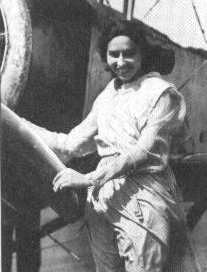
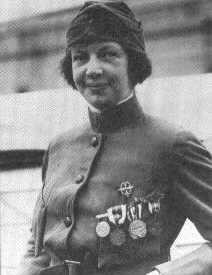
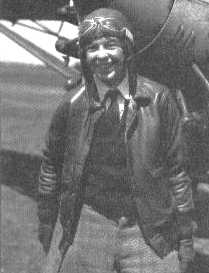
some great women of flight (from the left:
Katherine Stinson in 1916;
Ruth Law, one of the women who came closest to flying combat
missions for the
Allies in World War I, in 1919; and Elinor Smith, an
endurance champ
who flew out of Roosevelt Field, New York, in 1929
She returned to the United States
and began a barnstorming career
that spread her fame throughout
the Midwest. Coleman purposely
flew a Nieuport (a military plane)
and wore military clothes to
emphasize that she could fly a
plane as well as any military pilot.
The participation of the
pre-eminent women aviators
in the 1929 Women’s Air Derby, held at that
year’s Nationals, advanced
the cause of women’s aviation. The
contestants were all accomplished
fliers and record holders: Amelia
Earhart; Ruth Elder; Marvel Crosson
(sister of the famed Arctic
flier Joe Crosson and the only
fatality of the race); Blanche Noyes; Thea Rasche,
the famed German woman
aviator; Bobbi Trout; Florence
“Pancho” Barnes, acknowledged to be
one of the greatest
Hollywood stunt pilots and speed racers, male or female,
of the day; Ruth Nichols;
and the Australian long-distance
flier Jesse Miller.
The course was a long and hard
one, and there was evidence that
resentful individuals had tampered
with some of the equipment. The
winner, Louise (McPhetridge)
Thaden, already a simultaneous
holder of speed, altitude, and
endurance records for women
fliers, was now catapulted into the public spotlight and
became a hero to women everywhere.
Another positive result of the Women’s Air Derby was
the formation of an
association of women fliers called
the Ninety-Nines (after the number of charter members)
which had Amelia Earhart as its first president. The
Ninety-Nines promoted women’s aviation by
lobbying for women to be
allowed to enter air races (women had
been barred in 1930 because of
the death of Crosson, but
were allowed back the following year), and by publishing
The 99-er, a magazine highlighting the latest developments
in aviation and the careers of women fliers. Probably the
greatest triumph in aviation for women during this
period—even more important than the exploits of the great
long- distance fliers—was the victory of Louise Thaden and
Blanche Noyes in winning the Bendix Trophy in 1936.
The pair flew a new design from
Beechcraft, the Model 17 Staggerwing, a biplane with the
lower wing forward of the upper wing (instead of the other
way around, as was the case with most biplanes). They
completed the course hours before their nearest competitor.
The victory had an electrifying effect on women’s aviation;
the victory of Jacqueline Cochran in the 1938 Bendix race
was possible only because of the Thaden-Noyes victory two
years earlier. One could get a rousing argument going about
who was the best woman flier of the Golden Age, but there
wouldn’t he much disagreement about who was the grittiest:
that would be Ruth Nichols. Nichols was born into a wealthy
family and attended the finest schools; she was expected to
enter high society and take her place in the Social
Register. Because of her blue-blood background, she was
called the “Flying Debutante” by the press, a name she
hated.
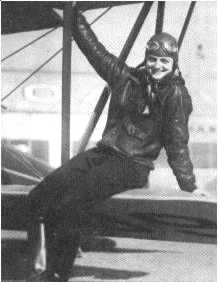
Louise Thadden was among the
most accomplished aviators of her day,
wining the 1936 Bendix Trophy in a
Beechcraft Model 17
Staggerwing.
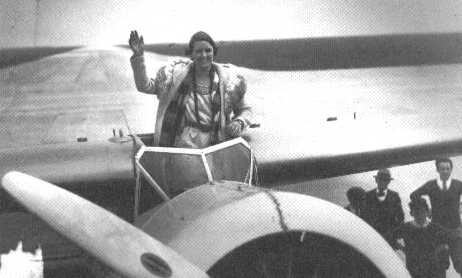
Ruth
Nichols seems a tad overdressed to pilot
her Vega for a 1931 test flight, but she
as as rugged and determined as any flyer
of the period.
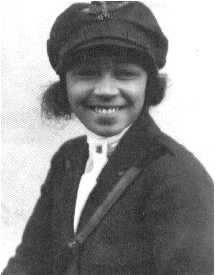
Bessie Coleman,
in a 1923 photo
became the first black woman
aviator
but she had to go to
England to get her license.
As
a graduation present, her stockbroker father treated her to
a ride in a barnstormer’s airplane, and as she would write
years later, “I haven’t come down to earth since.” While
vacationing in Florida during a break from her studies at
Wellesley, she took lessons from a barnstormer named Harry
Rogers, and she soon abandoned plans to enter medical school
and took up flying. Her big break came when Rogers asked her
to be his copilot in an attempt at a record-setting run from
New York to Miami in 1928. She was instantly propelled into
the spotlight and was able to dedicate herself to flying
full-time. She became a spokesperson for the Fairchild
Airplane and Engine Company and toured the country in her
trademark custom-made purple leather flight suit and helmet.
With a Lockheed Vega borrowed from radio
manufacturer Powel Crosley, and coached by Charles
Chamberlain, the noted test pilot for Whirlwind, Nichols set
several records in cross-country flying and altitude in
preparation for a solo flight to Paris along Lindbergh’s
route. Naming the plane the Akita (an Indian word meaning
“to explore”), she took off from New York on June 22, 1931,
to cross the Atlantic. Instead of stopping to refuel in
Portland, Maine, she went to an alternate site, St. John,
New Brunswick, with which she was unfamiliar.
The runway was
too short for so fast a plane and the Lockheed ploughed into
the forest at the end of the field. Nichols was badly
injured—she cracked five vertebrae—and was told it would be
a year before she could fly again, and even then only with a
thick steel body brace. But only a month later, Nichols was
supervising the repairs to the Akita and, still in her
plaster cast, preparing to take another run at the Atlantic.
The weather would not cooperate and, after a month’s delay,
she decided instead to try to beat the non-stop solo overland
distance record of 1,849 miles (2,958.4km) set by French
flier Maryse Bastie. This time, there would be nothing left
to chance.
She flew from New York to California, stopping at
each potential landing site along the way to become familiar
with the runways and the terrain. She took off from Oakland
and made it as far as Louisville, Kentucky, short of her
goal but still just breaking Bastie’s record. As she took
off to finish her journey, a leaking valve caught fire.
Nichols managed to land the plane and, now in her heavy and
cumbersome steel body brace, to climb out and leap clear
just as the plane exploded. The Akita was demolished, and
thus ended Nichols’ plans to cross the Atlantic.
|
